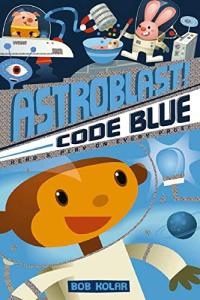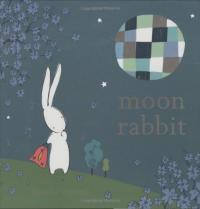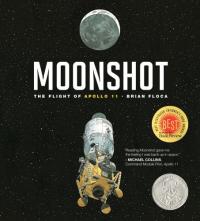
A Code Blue alarm sounds as a young (monkey) astronaut snoozes in the Astroblast Snack Shack. Other crew members — Apollo, Halley, Sputnik, and Jet — return to address the issue: welcome snacks must be made for their visitors! Readers will enjoy finding things hidden in the colorful illustrations (noted at the bottom of each spread) and just may be inspired to learn more about the origins of the animal crew members’ names.
Astroblast: Code Blue

Aldrin relates how he, the second man to walk on the Moon, became interested in aeronautics and flying. The result is a fascinating look at his personal history as well as the history of flight accompanied by precise but equally engaging illustrations.
Reaching for the Moon

The famous cat in a red and white striped hat is used to introduce basic information about space as well as space trivia. As in others in the series, the limited vocabulary in a predictable format provides easily accessed and understood information about a popular topic.
There’s No Place Like Space: All About Our Solar System

Poets have always looked to the sky for inspiration. A range of contemporary and older poets and their exploration of the stars, sky, moon — and more — are presented, illustrated with lush, evocative paintings.
Sky Magic

The encyclopedic presentation in an oversized format support about 200 photographs from NASA as well as other illustrations to chronicle the history of space flight. Rockets and the moon landing are also included. A DVD with historical footage from the moon landing completes this attractive package, sure to be enjoyed by a range of readers.
Mission to the Moon

When his teacher assigns a science project, 3rd grader Oliver is enthusiastic about doing it independently. His rather overprotective parents, however, have different ideas. How Oliver and his newfound friend and classmate overcome the obstacles makes for engaging reading with lots of laughs.
How Oliver Olson Changed the World

Made to look like a scrapbook, this history of man’s interest in space flight, the space race, and the first lunar landing will appeal to sophisticated readers. This detailed presentation requires multiple examinations.
One Small Step: Celebrating the First Men on the Moon

The Moon leads a small, lonely, city rabbit across the park to find a friend who shares her interest in story and music. Gentle, slightly abstract illustrations enhance the mellow language in which friends meet, part, and reunite.
Moon Rabbit

Poetic language and striking illustrations evoke the drama of the first lunar landing. Neil Armstrong and Buzz Aldrin’s first impressions are captured with awe and may well inspire young scientists.
One Giant Leap

Apollo 13 attempted to repeat Apollo 11’s successful Moon landing. An explosion, however, changed the mission to just get the astronauts home safely. Dual texts and dramatic illustrations tell the remarkable story and extend the information presented.
Lucky 13: Survival in Space

Apollo 11 astronaut Buzz Aldrin takes the reader on a journey through centuries of air and space aviation, from Isaac Newton to exploring Mars to futuristic space tours. Fascinating details and a timeline are embedded throughout.
Look to the Stars

Realistic but soft and evocative illustrations recall a boy’s wonder as man first walked on the Moon. This attractive book was rereleased in time for the 40th anniversary of this memorable event.
Footprints on the Moon

A rhyming text in an intriguing format introduces the Moon’s cyclical nature — its phases. An informational note concludes this introductory look at the Moon and why it appears to change.
Faces of the Moon

Young children will appreciate the basics of how astronauts travel, what they eat, and their spectacular view from space in this sturdy board book, just right for young hands.
Blast Off to the Moon

The alphabet is the device used to pique curiosity about astronomy, space travel, and things related from A to Z. Illustrations use different media to create the look from the Sputnik era for a playful introduction.
A is for Astronaut: Exploring Space from A to Z

Relive the journey of the Apollo 11 where the first people stepped on the Moon’s surface and saw Earth from a very different perspective. Eloquent language and illustrations combine to present this historical event in a unique, unforgettable way.
Moonshot: The Flight of Apollo 11

Stunning illustrations, recent photographs, and current information combine to present a compelling look at the various planets (including the dwarf planet Pluto), stars, and galactic mysteries. This authoritative presentation is by a well-known specialist in the field.
Planets, Stars and Galaxies

Short rhymes provide accurate glimpses at heavenly bodies, even noting Pluto’s new status. Each poem is accompanied by colorful, evocative illustrations. Additional information about the topic of each poem concludes this handsome volume.
Comets, Stars, the Moon & Mars: Space Poems and Paintings

This retelling of a Navajo folktale explains how First Woman tried to write the laws of the land using stars in the sky, only to be thwarted by the trickster Coyote.
How the Stars Fell into the Sky: A Navajo Legend

Have you ever wondered how the Milky Way came to be? According to a Cherokee legend, it started when an old couple learned that their corn was being stolen by a Great Spirit dog. To get away, the spirit dog jumps into the sky, spilling the corn. And we can still see the results today in the night sky.
The Milky Way: A Cherokee Tale

Hans Augusto Rey, best known as the creator of a small monkey named Curious George, was an amateur astronomer as well. He created this easy-to-follow guide to the night sky so that young people could get to know the constellations visible from their own backyards. A conversational, open text with simple but informative illustrations is sure to entice and inspire young star gazers.
Find the Constellations

Have you ever wondered how the Moon was placed in the sky? According to this Ashanti tale, Nyame, the god of all things, put it there when Anansi could not decide which of his sons deserved it. Brilliant illustrations accompany this classic retelling of a traditional tale.
Anansi the Spider: A Tale from the Ashanti

3…2…1…lift off! Take a journey into space exploration. With fun facts like what astronauts eat and how they sleep, kids will learn about today’s space adventures and how people from all over the world work to continue space exploration.
Astronauts Today

A brightly colored and intricately detailed space shuttle prepares for liftoff, then shoots into space, leaving Earth’s atmosphere and going into orbit.
